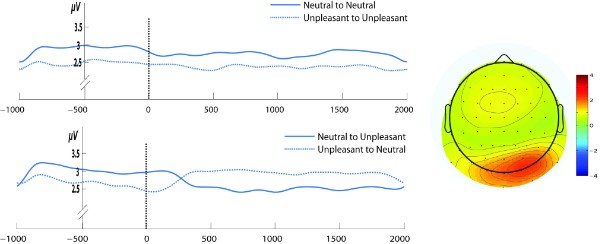V.D. Bekhtereva, M.M. Müller
Due to an error in the stimulus presentation program while recording the experiment using rapid serial visual streams of negative and neutral images shown at 6 Hz published in the article, unpleasant images were loaded in place of neutral ones and vice versa. This led to the reversed labelling of experimental conditions reflecting unpleasant and neutral condition category.
As a result, the legend of Fig. 5 and its caption had to be corrected and appear as follows:

Fig. 5. Left: Gabor filtered time-course of 6 Hz SSVEP amplitudes for the stream of unpleasant and neutral pictures with a change in emotional content (lower panel) and without such a change (upper panel). Time point zero shows the onset of change in emotional content. Right: The grand average of 6 Hz SSVEP amplitude across all subjects and conditions for the time period of 1 sec before and 2 after the change in emotional content
Two sentences of the manuscript (pp. 141–142) had to be corrected: “However, as depicted in Fig. 5, with the presentation rate of 6 Hz, SSVEP amplitude decreased significantly when the picture stream changed from neutral to unpleasant pictures, and increased when the presentation of images of negative content switched to that of neutral ones (lower panel). When we presented an entire stream of either emotional or neutral images, continuously lower SSVEP amplitudes were observed for affective compared to neutral images (upper panel)”.
Thus, the reversed coding for neutral and unpleasant image categories altered the direction of the SSVEP emotional modulation: amplitudes decreased with emotionally unpleasant compared to neutral pictures.

The content is available under the license Creative Commons Attribution 4.0 License.